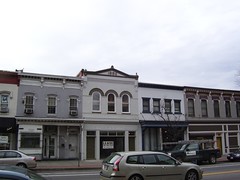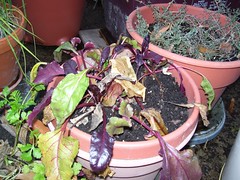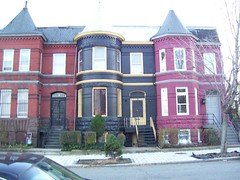A landlord who owns two houses on my street has recently put his houses up for sale. He originally bought the houses for $80K and $139K and is now listing them for $390K and $450K. I think that is a tad too much. Not only because it’ll make my assessment go up, but if anyone hasn’t heard there is a slow down in the RE market. Knock off about $50K from both of them to be somewhat ok.
Both places still have renters in them. There has been some gossip/rumor on the street that these are Section 8 houses. One house’s residents are pretty good, don’t make a lot of noise, not a lot of traffic going in or out, no people hanging in front, in essence they fit in. The other house, well they are much, much better now as opposed to when the residents first arrived.
So the $840,000 question is if the houses sell, will they remain rentals?
Let me throw in a pitch to encourage you to buy one of these houses (when the price gets lowered to something reasonable) so you can live on my block. One, we have a wonderful little block, where if you do stuff in your yard, you will totally make friends with your neighbors. If your interests include cycling, motorcycles, gardening, construction, or your toddler/baby, you will find friends. It’s not too hard to find a parking spot (but not super easy either). The lower priced house has some decent yard space, and a rear yard that, if you have no plans to grow anything back there, you could turn into a parking spot for a compact car.
Month: January 2008
Devil’s Advocate
Remember the chapter in Freakonomics “Why Do Drug Dealers Still Live With Their Moms?” Well go up a little in the heirarchy and expand it, and you have Dr. Sudhir Venkatesh’s Gang Leader for a Day a 302 page book about the years Dr. Venkatesh hung out with a drug dealing gang in the Robert Taylor Homes in Chicago. I could barely put this book down as it was so interesting.
I couldn’t help but think of our own little groups around the hood as I read and I held on to various themes in my head. One theme being nature abhors a vacuum, particularly in terms of power. The gangs were one power group, controlling or working with, or negotiating with other groups. The other theme was that of complexity. Drugs were one source of income, the gangs also levied taxes on squatters, prostitutes, and hustlers. However the gangs weren’t the only ones collecting ‘taxes’ on underground trade.
Two things that I thought were most useful in the book, for my understanding, were how the gang saw themselves as being part of the community and what undermined the gang. I have heard before, and in great disbelief, that the hangers out help the community. From Venkatesh’s study I see where that assertion comes from, in that the community leaders at Robert Taylor were able to get funds and co-operation for programs from gang leaders. There is some irony in a program to get kids off the street and away from gangs, partially funded by a gang. Towards the end, when the author was winding up his studies, two things were occurring, the Robert Taylor Homes were slated for demolition and a federal crackdown on drug trafficking. Together those two things removed the customers, the taxable underground economy, and valuable experienced staff (dealers, enforcers, etc).
In the case of Shaw, gentrification probably helps break up some networks, by reducing the number of underground consumers in the area and reducing the amount of influence certain groups have. I’m going on 7 years here in the hood (good lord I’m getting old), and I have seen the drug activity around here decrease, since my arrival. I’ll credit aspects of gentrification to that decrease, in that several vacant buildings that hid or facilitated illegal trade, are now filled and cannot be used for that sort of thing. New residents tend to support with their numbers the kind of leadership, political pushes and social reforms that weaken the drug dealing structure, adding to old timers who may have been too few in number to get any traction.
D-lemma
You say nice things about a place to a lot of people and it gets so popular that it’s almost too crowded for you….
But anyway, Big Bear, still good, still got coffee grounds for the old garden, but weekends are busy. I was lucky to find a table. I’m curious to see what the crowd is like on Tuesdays when the local knitting club meets.
Also I haven’t talked about Thai X-ing lately. Well Taw has help and the food comes quicker than before. Not fast, but quicker. Remember the long waits? Now, when he (or whomever answers the phone) says 25 minutes, it is ready in 25 minutes. Panang Tofu still good, but the Yum Woon Sen with shrimp is my new favorite dish. Now that I’ve told you this don’t be over ordering it so there is none left for me when I order.
People over things
This comes out of some email correspondence I had this week about an inquiry about a Shaw house’s history. Sometimes you can find the date of when something was built, sometimes not. The date on my lovely domicile is based on tax records, one year it’s taxed as land, next year land and an improvement, no permit, and zilch about a builder. However, my interest in structures, my own particularly, is based on maintenance and bases for complaints when it comes to maintenance and the inadequacies of the building.
I have a greater interest in flesh and blood than bricks and mortar. People do things, they go to work, they have families, they have relationships, they have a story, and the place where they live is absolutely uninteresting without them.
And the people I’m most interested in are the ones who lived around here. This is to differentiate from the landlords who most likely, didn’t. I’m picking up from some of you a thinking that the focus should be on the property owner. Maybe in other parts of the country, maybe the place where you came from, people built and bought homes to live in. Maybe they made their little plot, a family home, where at least one generation would remember it fondly as the place they grew up and a place to return. Not the case here. The owners were landlords, their family homes were elsewhere. In the case of the woman who once owned my house, it was just another investment, something that could be bought and sold and rented out for income.
From the 1880 to 1930 census stuff I’ve seen, there were a lot of renters in the neighborhood. And I’ve noticed these people moved around. I was trying to find out who was the earliest family to live at a certain TC house on the 1500 blk of 1st Street. I found the family living there a few years after the date the house was built, and when I went back through the city directory (arranged by name) to see if the house existed a previous year (and it would be confirmed by that family being there in those previous years), that family lived further up 1st in Eckington.
The fun question then becomes, why move around? Why stay in a place for only a few years only to move 1/4 mile somewhere else? Why can’t you stay in one spot? The building just sits there, and doesn’t generate a lot of questions for me. The building is the backdrop, the scenery, the stage, but the play is nothing without the performers.
I’ve rambled enough, but sometime later I want to return to the idea of what it means to be an area with a very restless renter population.
Hypotherma and the homeless
It’s still cold. Not as cold as the past couple of days, and hopefully it will be warming up later this week. But anyway, as a reminder to myself and y’all gotta put 1-800-535-7252 in the cell phone for the Hypotherma Hotline to report people sleeping on the streets when the weather is below freezing, 32F.
Ugly no mo'
Remember this sight?
Well the Check N’ Go is Gone. Reading Marc Fisher’s article this weekend, I gather DC laws have made the District an unwelcoming place for payday lenders. I haven’t bothered to notice if the check cashing place on the 400-500 blk Rhode Island Avenue is still in operation. But for what ever reason that bit of entrepreneurial ugly is gone. When you pass by the building now, the weird windows are now 3 perfectly unnoticeable ones and the building got a paint job.
Clean off your sidewalk
Most of the slush has melted but….
Residents, Merchants: Please Remember to Shovel Your Sidewalks When
Posted by: “Lyons, Nancee (DPW)” Nancee.Lyons-at-dc.gov
Thu Jan 17, 2008 10:29 am (PST)
Residents, Businesses Urged To Clear Snow/Ice from Sidewalks, EntrancesDPW Encourages Citizens to Help Others Unable to Shovel
The Department of Public Works (DPW) urges District residents and businesses to clear their sidewalks, sidewalk entrances, nearby catch basin openings, and the area surrounding hydrants of snow, sleet and ice to prevent injury to pedestrians. DPW also asks businesses to make sure the handicap ramps located at intersections are clear of snow and ice.
“After a snowfall, we get many complaints from pedestrians who are having difficulty traveling because so many residents and business owners don’t clear their sidewalks,” said DPW Director William O. Howland, Jr. “I want to remind residents that DC law requires all property owners to clear snow, sleet or ice from the walkways surrounding their property within the first eight hours of daylight
after a snow storm ends.”
While DPW does not have the authority to issue tickets to residents for failure to remove snow from sidewalks, the agency can and will enforce this law with commercial property owners. The main goal however, says Howland, is to educate both residents and business owners about their responsibilities during a snow event and to encourage them to be good neighbors.
“When I was a kid, we made a little extra money shoveling snow and helped our elderly, ailing, and frail neighbors,” Howland said. “It’s important to establish and maintain a sense of community in our neighborhoods.
“Many communities have developed lists of those willing to shovel snow for neighbors who are unable to shovel on their own,” Howland continued. “I encourage all communities to identify those in your neighborhood who are willing to provide this service so that our sidewalks are safe and passable for all.”
For more information about how the District handles snow events, visit DPW at www.dpw.dc.gov on the Internet.
Nancee Lyons
Public Affairs Specialist
DC Department of Public Works
2000 14th Street, NW
Washington, DC 20009
(202) 671-2637
www.dpw.dc.gov
Of course, I don’t pay the neighborhood kids or lawn guys for shoveling, I’ve seen the quality of their work.
Pot o' Beets
Last night was another Restaurant Week night and once again, there was a beet salad choice, which I ordered. It was 3 slices of seared red and yellow beets with salt and oil and something else, and it was good. My childhood interactions with beets have been unhappy ones, with diced canned beets with the blood red runoff pooling on the plate and I just didn’t like the taste. Now, I’m discovering that beets can be good.
Last year I found out that beet greens were tasty, so I decided to grow a few. The picture you see was taken a few days ago in the back yard and well, though not exactly perky, the beets are doing fine. I think I planted those sometime in early fall, and kind of ignored the backyard since then. After experiencing great beet root salad, I might try my hand at it with the tiny beets in the pot there. I have eaten the roots, but only when thinning the pot and the roots were thin and not round and I cooked them up with the tops. Whatever flavor they might of had, probably got masked by the greens.
The great thing about growing my own stuff is that I can try to grow fancy stuff that I might not find at the market. So this year the plan includes red and golden beets. I order a seed for peach toned tomatoes, and I may try for the green and yellow zebra striped tomatoes again. There are some reddish bottomed spring onion things I’m going to try as well as some other interesting looking veggies.
Some of you have seen my yard, and you know it is nothing special. But from this small yard with so-so light and my bad habit of not watering things as I should, I’ve been able this winter to run out and grab some arugula for a pasta dish, dill for a gravlax, mint for garnish, and sage for a chicken dish. All within 3ft of my front door. Of course, I think the plants are benefiting from heat loss from the uninsulated parts of the house, and that could explain the bounty too.
Corduroy
Restaurant Week is sometimes an excellent chance to check out some places you normally can’t get to for one reason or another. This time it was a added treat in that IT chose a place that will be relocating to Shaw, specifically 9th Street across from the Convention Center, Corduroy.
After eating there I say, YAY! Not just because it is a white table cloth adult male waitstaff* type restaurant. No, the food is great. I really liked the parsnip soup. Not too salty, not too heavy, nice and creamy. The beet salad made me want to grow more beets this year. The rest of the meal was excellent, and filling. Try the hazelnut chocolate bars, they’re like really high-end Kit-Kats.
B. joked about the possible competition Corduroy would bring to ODB and the Mongolian Grill. Different audiences. I go to the Grill for decent cheap take out sushi. Since I have no interest in sitting around drinking beer and watching screens of people doing things with balls, I tend not to go to ODB often. The competition would be Acadiana facing 9th on New York Avenue, also participating in Restaurant Week. Maybe Vegetate, also participating, but it’s further up 9th.
Well, I hope that Restaurant Week 2009 and 2010 will see more choices along 9th.
*I know, I’m horribly sexist. But in my little mind there is something oh so special about a serious looking mature man in a long white apron and dark suit pouring my wine, over some chipper whippersnapper. I’m also getting old, so I’m getting ageist as well.
Townhouses of Truxton
I really don’t have much to blog about today as I am still recovering from the nasty cold that had me off of work for two days, couch bound and missing church this weekend.
If you haven’t noticed I’ve been adding to my Flickr set “Townhouses of Truxton” slowly but surely and it has been filling out quite nicely. I’ve got P-R Streets covered as well as Bates, 1st and 4th. I could stand to do more with Florida and New York Avenues and more of the Hanover (or any Hanover, I got no Hanover St) street area. My goal is to try to show the variety and similarity of the buildings from the late 20th Century Co-op that commands a nice chunk of upper Truxton to the early 20th Century mass produced investment housing (lest y’all start waxing romantic about Victorians), to the cramped 19th century Federals that by the Grace of G-d haven’t crumbled into dust.
There are over 120 photos in the set and I’ll add more as I get out early enough to take pictures when few people are milling about.
There are also pix of houses in the NE section of the TC. For most things I tend to cut Truxton off at North Cap, but for the fun of it, I’m adding the section that really isn’t in Eckington and has only a handful of houses.




